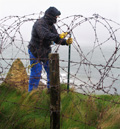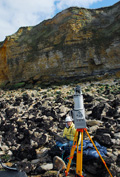
A blast of wintry weather greeted Texas A&M University graduate students and professors from the College of Architecture during their spring break 2008 trip to Pointe du Hoc in Normandy, France, as they continued to document the historic World War II site.
“It was cold, around 40-45 degrees, rainy and windy, with winds blowing from 40-60 miles an hour all the time,” said Robert Warden, professor of architecture and director of the Center for Heritage Conservation. “We had a couple of days in there that were decent days to work with, but for the most part it was a lot of wind and a lot of rain to mess with. We had to go through some extraordinary measures to make sure we got our data.”
The site, where U.S. Army Lt. Col. Earl Rudder led a charge up 90-foot cliffs to engage the German Army during the World War II D-Day invasion, is in danger of collapsing into the English Channel because of the erosion caused by the high winds and constant pounding from the channel’s waters. Rudder, who survived the carnage, went on to become president of Texas A&M.
“We’re studying the failures of the cliff and trying to understand how to mitigate those failures,” said Warden. “The more the cliffs erode away, they put in danger some significant buildings at Pointe du Hoc, the most significant of which is the observation post that has the memorial to the 2nd Ranger battalion on it,” he said.
Because of the cliff’s erosion the memorial is closed to the public for safety reasons.
“We think we can prolong the life of the cliff and the monument by backfilling some of these caverns that are forming at the bottom of the cliff, and that will prevent these sorts of catastrophic failures that are putting the observation post at risk,” he said.
During their visit, the Texas A&M team scanned the caverns in detail to determine how much concrete is needed to fill them and shore up the cliffs.
The team is also considering the use of “micropiles,” to stabilize the observation post. “Micropiles,” Warden said, “are basically concrete columns that would be placed 40 meters deep down into the bedrock underneath the observation post.”
The Pointe du Hoc team worked daily, beginning with a 6:30 a.m. breakfast and ending around 7 p.m, just before dark. They stayed in a rented 12-bedroom, 6-bathroom house about 15 minutes away from the site.
The topography of the Pointe du Hoc site required the researchers to learn how to rappel.
“The only way to get to the beach is to rappel down the cliff, so we would rappel down and lower the equipment down too,” said Warden. Getting set up and getting all the equipment ready to go is about a two-and-a-half-hour process.”
In addition to dealing with the harsh elements, the team had to work around the coming and going of high tide.
“We would usually start a couple of hours after high tide, when there’s enough beach exposed so we could get ourselves and everything down there: the total station, scanner, tripods, car batteries, backpack of tools, a camera … we need the whole thing in order for it to work. If you forget something, you can’t just go back and get it.”
Landing on the Pointe du Hoc beach isn’t really a day at the beach either.
“It’s not beach like a sandy beach, it’s covered by huge boulders. It’s very slippery too, because the boulders have seaweed and moss growing over them,” said Warden. “It’s dangerous to walk on without even carrying anything, but getting equipment from one position to another is one of the more challenging parts of the whole process.”
The daily ordeal gave the Texas A&M team a greater appreciation for wartime feat accomplished by Rudder’s Rangers, who scaled these same cliffs amid a hail of German gunfire.
Writing for MilitaryHistoryOnline.com, Thomas M. Mingus quotes Omar Bradley, the commanding general of the First U.S. Army, as saying, “No solider in my command has ever been wished a more difficult task than … Rudder.”
Mingus wrote that Rudder thought the whole plan—to scale the cliff under enemy fire, then destroy 155mm German guns, then establish a roadblock on a road that ran along the coast from Omaha beach—was so dangerous it was a practical joke.
After learning the mission was no joke, however, Rudder set about training his men, whose performance landed them in history books.
Though the researchers didn’t have to deal with enemy fire, they had their hands full competing with the elements.
“You want to do your most difficult, far-out scans when the tide is out, move further in and complete more detailed scans closer to the cliff as the tide moves back in, and then have enough time to get the equipment out and get out of Dodge,” he said.
When the tide schedule wasn’t cooperating, the team could work on the battlefield.
“There’s a lot of work we could do on the surface,” said Warden. “There are three major buildings to scan, and we would do surveying and scanning work until the timing worked out to where we could actually get to the beach. We went back and forth between those kinds of things.”
Throughout their visit, the team had to work in constant rain.
“Our total station is able to operate in light rain, but if it’s heavy rain you have to cover it,” he said. “The laser scanner can operate in full rain, but it needs a computer to run it. So we got the tent and put the computer operator in it, while the scanner operator worked outside.”








